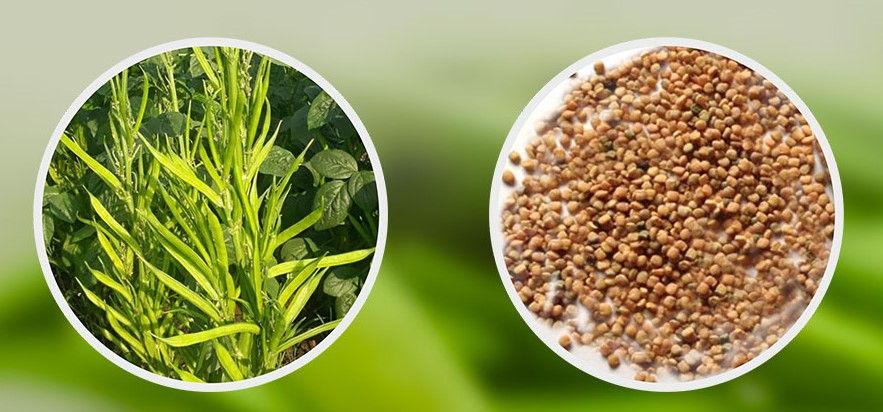Guar gum, also called guaran, is a galactomannan polysaccharide extracted from guar beans that has thickening and stabilizing properties useful in food, feed, and industrial applications. The guar seeds are mechanically dehusked, hydrated, milled and screened according to application. It is typically produced as a free-flowing, off-white powder.
Guar beans and seeds


Molecular Structure
Chemically, guar gum is an exo-polysaccharide composed of the sugars galactose and mannose. The backbone is a linear chain of β 1,4-linked mannose residues to which galactose residues are 1,6-linked at every second mannose, forming short side branches. Guar gum has the ability to withstand temperatures of 80 °C for five minutes.
Grades
Manufacturers define different grades and qualities of guar gum by the particle size, the viscosity generated with a given concentration, and the rate at which that viscosity develops. Coarse-mesh guar gums will typically, but not always, develop viscosity more slowly. They may achieve a reasonably high viscosity but will take longer to achieve. On the other hand, they will disperse better than fine-mesh, all conditions being equal. A finer mesh, such as a 200 mesh, requires more effort to dissolve. Modified forms of guar gum are available commercially, e.g. partially depolymerized or hydrolyzed guar gum.
Solubility & Viscosity
Guar gum is more soluble than LBG (locust bean gum) due to its extra galactose branch points. It is not affected by ionic strength or pH but will degrade at extreme pH and temperature (e.g. pH 3 at 50 °C). It remains stable in solution over the pH range of 5–7. Strong acids cause hydrolysis and loss of viscosity; alkalies in strong concentration also tend to reduce viscosity. The viscosity attained is dependent on time, temperature, concentration, pH, rate of agitation and particle size of the powdered gum used. The lower the temperature, the lower the rate at which viscosity increases, and the lower the final viscosity. Above 80°, the final viscosity is slightly reduced. Finer guar powders swell more rapidly than larger particle-size coarse powdered gum.
Thickening
One significant use of guar gum is as a thickening agent in foods and medicines for humans and animals. Because it is gluten-free, it is used as an additive to replace wheat flour in baked goods. It has been shown to reduce serum cholesterol and lower blood glucose levels.
Guar gum is economical because it has almost eight times the water-thickening ability of other agents (e.g. corn starch), and only a small quantity is needed for producing sufficient viscosity.
In addition to guar gum’s effects on viscosity, its high ability to flow gives it favourable rheological properties. It forms breakable gels when cross-linked with boron. It is used in various multi-phase formulations for hydraulic fracturing (fracking), in some as an emulsifier because it helps prevent oil droplets from coalescing, and in others as a stabilizer to help prevent solid particles from settling and/or separating.
Food Applications
The largest market for guar gum is in the food industry.
Guar gum has the E number E412.
In baked goods, it increases dough yield, gives greater resiliency, and improves texture and shelf life; in pastry fillings, it prevents the syneresis of the water in the filling, keeping the pastry crust crisp. It is often used in hypoallergenic recipes that use different types of whole-grain flour. Because the consistency of these flours allows the escape of gas released by leavening, guar gum is helpful to improve the thickness of these flours, allowing them to rise similarly to normal flour.
In dairy products, it thickens milk and yoghurt and fresh cheese products and helps maintain the homogeneity and texture of ice creams and sherbets. It is used for similar purposes in plant-based kinds of milk.
For meat products, it functions as a binder.
In condiments, it improves the stability and appearance of salad dressings, BBQ sauces, relishes, ketchup and others.
In canned soup, it is used as a thickener and stabilizer.
It is also used in dry soups, instant oatmeal, sweet desserts, canned fish in sauce, frozen food items, and animal feed.
